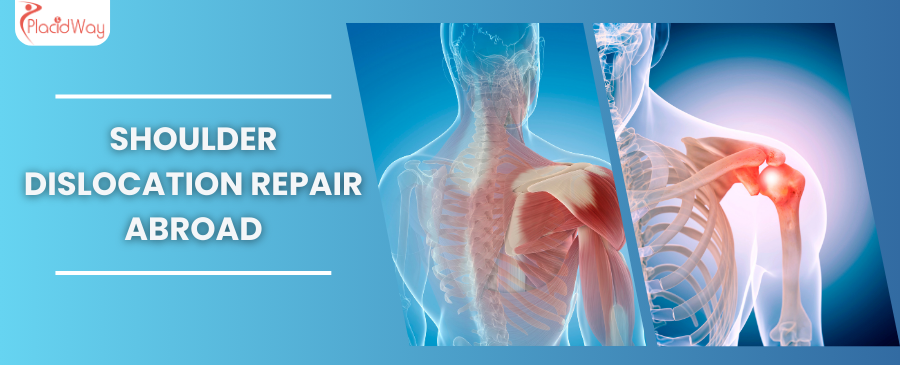
Regain Freedom: Advanced Shoulder Dislocation Repair for Lasting Stability
A dislocated shoulder can be a profoundly painful and disruptive experience, often leaving individuals with a feeling of instability and a fear of re-injury. If you've suffered one or more shoulder dislocations, you know how debilitating it can be, impacting everything from daily chores to your favorite sports. The good news is that advanced medical solutions, particularly shoulder dislocation repair, offer a pathway to regaining lasting stability and a pain-free life.
Shoulder dislocation repair is a surgical procedure aimed at correcting the underlying issues that lead to recurrent dislocations. It's not just about popping the shoulder back into place; it's about fixing the damaged ligaments, tendons, and sometimes even bone that allow the shoulder joint to become unstable. This procedure is commonly sought by active individuals, athletes, or anyone whose quality of life is severely affected by persistent shoulder instability.
Understanding the symptoms of a dislocated shoulder, its causes, and the available treatment options is the first step toward recovery. Many patients, faced with high costs or long wait times in their home countries, are now exploring medical tourism for this specialized procedure. Destinations worldwide offer cutting-edge facilities, experienced surgeons, and significantly more affordable prices, making quality care accessible.
This comprehensive guide will walk you through everything you need to know about shoulder dislocation repair, from understanding the condition to exploring your options for treatment abroad. Our goal is to empower you with knowledge, so you can make an informed decision about restoring your shoulder's health and reclaiming your freedom of movement.
1. Symptoms of a Dislocated Shoulder: What to Look Out For
When your shoulder dislocates, it's usually a dramatic and painful event. The humeral head (the ball of your upper arm bone) completely separates from the glenoid (the socket of your shoulder blade). Here are the key indicators:
- Severe Pain: Often sharp and immediate, intensifying with any movement.
- Visible Deformity: The most obvious sign is that the shoulder looks visibly out of place, often creating an unnatural bulge or a "squared-off" appearance.
- Swelling and Bruising: Inflammation and bleeding into the tissues surrounding the joint are common.
- Inability to Move the Arm: You'll likely find it impossible or extremely painful to lift or rotate your arm.
- Numbness or Tingling: Nerve compression can cause sensations of numbness, tingling, or weakness in the arm or hand.
- Muscle Spasms: The muscles around the shoulder may go into spasm, further increasing pain and making reduction difficult.
If you experience any of these symptoms, especially after a fall or direct impact, seek immediate medical attention. Prompt reduction of the dislocation is crucial to minimize further damage.
2. Causes and Risk Factors for Shoulder Instability
The shoulder is the body's most mobile joint, but this flexibility comes at the cost of stability. Several factors can lead to a dislocation:
- Traumatic Injury: This is the most common cause. A direct blow to the shoulder, a fall onto an outstretched arm, or a forceful twisting motion can pop the shoulder out of its socket. Sports like football, rugby, basketball, and skiing are common culprits.
- Previous Dislocations: Once you've dislocated your shoulder, the ligaments and capsule that hold it in place can be stretched or torn, making future dislocations more likely. This is often referred to as "recurrent shoulder instability."
- Ligamentous Laxity: Some individuals naturally have looser ligaments throughout their body, making them more prone to dislocations. This can be a genetic predisposition.
- Underdeveloped Shoulder Muscles: Weak muscles surrounding the shoulder joint may not provide adequate support, increasing the risk.
- Repetitive Overhead Activities: While not a direct cause of acute dislocation, activities like pitching or swimming can stretch the shoulder capsule over time, contributing to instability.
Understanding these causes is key to prevention and determining the most effective treatment for shoulder pain and instability.
3. Types of Shoulder Dislocation Repair Procedures
The choice of surgical procedure depends on the extent of damage, the direction of dislocation, and whether there's bone loss. The two main categories are:
Arthroscopic Stabilization (Minimally Invasive)
This is the most common approach. Small incisions are made, and a tiny camera (arthroscope) and specialized instruments are used to repair the damaged tissues. Common arthroscopic procedures include:
- Bankart Repair: Repairs a tear in the labrum (a rim of cartilage around the shoulder socket) that commonly occurs during dislocation. Stretched ligaments are also tightened.
- Capsular Shift: Tightens the joint capsule, which can become stretched out after recurrent dislocations.
Benefits: Smaller incisions, less pain, faster initial recovery, and reduced scarring.
Open Stabilization (Traditional Surgery)
In cases of significant bone loss from the glenoid (socket) or humeral head, or when arthroscopic repair has failed, an open procedure may be necessary. This involves a larger incision to directly access and repair the joint.
- Latarjet Procedure: Involves transferring a piece of bone (coracoid process) with its attached muscles and ligaments to the front of the glenoid. This creates a bone block and a sling effect from the transferred muscles, effectively preventing further dislocations.
- Remplissage: Addresses Hill-Sachs lesions (a dent in the back of the humeral head) by filling the defect with rotator cuff tissue to prevent it from catching on the glenoid rim.
Benefits: Often more effective for complex cases, significant bone loss, or failed arthroscopic repairs, offering robust stability.
4. Who is a Candidate for Shoulder Dislocation Repair Surgery?
Not every dislocated shoulder requires surgery. Often, a first-time dislocation is treated with reduction, immobilization, and physical therapy. However, surgery becomes a strong consideration for:
- Recurrent Dislocations: If your shoulder dislocates multiple times, it’s a clear sign of persistent instability that often requires surgical intervention.
- Young, Active Individuals: Especially those involved in overhead or contact sports, as they have a higher risk of re-dislocation after conservative treatment.
- Significant Ligament or Labral Damage: If imaging (like an MRI) shows extensive tears to the labrum (e.g., Bankart lesion) or ligaments.
- Bone Loss: If there's a significant fracture or bone defect on the humeral head (Hill-Sachs lesion) or glenoid (bony Bankart), which reduces the effective depth of the socket.
- Failed Conservative Treatment: If physical therapy and bracing haven't successfully stabilized the shoulder.
- Impact on Quality of Life: When shoulder instability significantly limits daily activities, work, or hobbies.
A thorough evaluation by an orthopedic surgeon, including physical examination and imaging, is crucial to determine if you are a suitable candidate.
5. Recovery Time and Expectations After Shoulder Surgery
Recovery from shoulder dislocation repair is a gradual process that demands patience and commitment to rehabilitation. Here's a general timeline and what to expect:
- Immediate Post-Op (Days 0-7):
- Pain management with medication.
- The arm will be immobilized in a sling, often for 3-6 weeks, to protect the repair.
- Gentle, passive range-of-motion exercises may begin under therapist guidance.
- Early Rehabilitation (Weeks 1-6):
- Continued sling use.
- Focus on protecting the repair while gradually increasing passive and then active-assisted range of motion.
- No lifting, pushing, or pulling.
- Intermediate Rehabilitation (Weeks 6-12):
- Sling typically discontinued.
- Introduction of active range-of-motion and gentle strengthening exercises.
- Focus on restoring normal movement patterns and muscle control.
- Advanced Strengthening (Months 3-6):
- Intensive strengthening of the rotator cuff and periscapular muscles.
- Progression to more functional and sport-specific exercises.
- Return to Activity (Months 6-12+):
- Gradual return to sports and strenuous activities, often requiring specific drills and assessments to ensure readiness.
- Full return to contact or overhead sports may take 9-12 months or longer.
Your adherence to the physical therapy program is the single most important factor for a successful outcome. Think of it like rebuilding a bridge – the foundation needs time to set before you can put heavy traffic on it.
6. Risks and Potential Side Effects of Shoulder Repair
As with any surgical procedure, shoulder dislocation repair carries potential risks and side effects, though serious complications are rare:
- Infection: Though sterile techniques are used, there's always a small risk of infection at the surgical site.
- Nerve or Blood Vessel Damage: Nerves and blood vessels run close to the shoulder joint and can, in rare cases, be injured during surgery. This can lead to numbness, weakness, or circulatory problems.
- Stiffness (Loss of Range of Motion): Some patients may experience a degree of stiffness post-surgery, requiring aggressive physical therapy to regain full mobility.
- Recurrence of Dislocation: While the surgery aims to prevent this, there's a small chance of re-dislocation, especially in very active individuals or after subsequent trauma.
- Scar Tissue Formation: Excessive scar tissue can sometimes lead to discomfort or restricted movement.
- Anesthesia Risks: Reactions to anesthesia, such as nausea, dizziness, or more serious cardiac or respiratory issues, are possible.
- Hardware Complications: If anchors or screws are used, they can sometimes become irritated or require removal, though this is uncommon.
Your surgeon will discuss these risks with you in detail, ensuring you are fully informed before proceeding with the operation.
7. Worldwide Cost Comparison for Shoulder Dislocation Repair
The financial burden of shoulder dislocation repair can be substantial, particularly in Western countries. This disparity in costs is a primary driver for the growing trend of medical tourism. Here's a general cost comparison, keeping in mind that these are estimates and can vary based on the specific procedure, hospital, surgeon, and complexity of the case:
| Country | Estimated Cost (USD) | Notes |
|---|---|---|
| United States | $15,000 - $35,000+ | Highest costs, often including surgeon fees, facility fees, and anesthesia. |
| United Kingdom | $12,000 - $25,000+ | High costs in private sector; public healthcare (NHS) may have long wait times. |
| Germany | $10,000 - $20,000 | High quality of care, robust healthcare system. |
| Thailand | $5,000 - $10,000 | Excellent value, renowned for modern facilities and skilled surgeons. |
| Mexico | $4,000 - $8,000 | Affordable option, especially for North American patients seeking proximity. |
| India | $3,500 - $7,000 | Very cost-effective with highly skilled, English-speaking surgeons. |
| Turkey | $6,000 - $12,000 | Emerging medical tourism hub with advanced medical infrastructure. |
These figures highlight why "shoulder surgery cost abroad" is a common search term, driving many patients to explore international options.
8. Why Consider Shoulder Dislocation Repair Abroad?
For many patients, the decision to seek medical treatment abroad for shoulder dislocation repair is a practical and often life-changing one. Here's why it's gaining popularity:
- Significant Cost Savings: As seen in the table above, the cost of surgery can be dramatically lower in many countries, even when factoring in travel and accommodation. This is often the primary motivator.
- Access to Immediate Treatment: In countries with universal healthcare, wait times for elective surgeries can be extensive. Traveling abroad often allows for quicker access to necessary procedures.
- World-Class Expertise: Many international hospitals boast highly skilled, internationally trained surgeons and state-of-the-art facilities that rival those in Western nations.
- Advanced Technology and Techniques: Some clinics abroad specialize in specific advanced techniques or utilize cutting-edge equipment that may not be readily available in your home country.
- Privacy and Anonymity: For some, the privacy offered by undergoing treatment away from their local community is appealing.
- Recovery Vacation: Combining treatment with a relaxing recovery period in a new environment can be a significant psychological and physical benefit.
It's about getting high-quality care without the prohibitive price tag or the frustration of prolonged waiting.
9. Which Countries Offer the Best Value for Shoulder Surgery?
When searching for "best country for shoulder surgery abroad," several nations consistently rise to the top for their blend of quality, affordability, and patient-focused services:
- Thailand: A pioneer in medical tourism, Thailand offers world-class hospitals, JCI-accredited facilities, and highly experienced surgeons. Cities like Bangkok and Phuket are popular medical destinations.
- Mexico: Especially popular with North American patients due to its proximity, Mexico provides affordable, quality care in modern facilities, particularly in border cities and major hubs like Mexico City and Cancun.
- India: Known for its extremely cost-effective treatments, India boasts a large pool of highly qualified, English-speaking surgeons and state-of-the-art hospitals, particularly in cities like Chennai, Mumbai, and Delhi.
- Turkey: An increasingly popular choice, Turkey offers advanced medical technology, internationally accredited hospitals, and competitive pricing, particularly in Istanbul and Ankara.
- South Korea: While potentially a bit pricier than some other Asian destinations, South Korea is globally recognized for its cutting-edge medical technology and highly specialized doctors, offering exceptional quality.
- Colombia & Costa Rica: These Latin American countries are emerging as strong contenders, providing high-quality care in picturesque settings, with growing medical tourism infrastructure.
These destinations not only offer excellent medical care but also a supportive environment for recovery, often with dedicated medical tourism facilitators.
10. What to Expect When Traveling for Shoulder Dislocation Repair?
Embarking on a medical journey abroad requires careful planning and knowing what to expect can ease anxieties:
- Initial Consultation & Planning: You'll typically start with an online consultation, sharing your medical history, imaging (X-rays, MRI), and discussing your case with an international medical coordinator or surgeon. This is where a service like PlacidWay becomes invaluable.
- Travel Arrangements: Once you decide on a clinic and surgeon, you'll arrange flights, accommodation, and potentially a local guardian or companion. Many medical tourism agencies offer packages that include these logistics.
- Arrival & Pre-Operative Assessments: Upon arrival, you'll undergo in-person consultations, a thorough physical examination, and any necessary pre-operative tests to confirm your suitability for surgery.
- The Procedure: The surgery itself will proceed as planned, followed by a hospital stay of a few days, depending on the procedure and your recovery.
- Post-Operative Care & Recovery: This is critical. You'll need to remain in the country for a period, often 1-3 weeks or more, for initial follow-up appointments, wound care, and to begin initial physical therapy. This ensures you're stable enough for travel and understand your rehabilitation program.
- Language & Cultural Support: Many medical tourism facilities offer multilingual staff, translation services, and cultural sensitivity training to ensure a smooth experience.
Think of it as a carefully orchestrated journey, where every step is designed to optimize your treatment and recovery experience.
11. How to Ensure Safety and Quality for Treatment Abroad?
Safety and quality should be paramount when choosing medical care abroad. Don't compromise. Here's how to ensure you're making a sound decision:
- Accreditation: Look for international accreditations like the Joint Commission International (JCI). JCI accreditation signifies that a hospital meets stringent international quality and safety standards.
- Surgeon Credentials & Experience: Research your surgeon's qualifications, experience, and specialization. Many international surgeons are board-certified in Western countries and have extensive experience with specific procedures like shoulder arthroscopy.
- Hospital Reputation: Read patient testimonials, reviews, and success stories. Look for hospitals known for their orthopedic departments and patient-centered care.
- Transparency in Pricing: Ensure the clinic provides a comprehensive quote that includes all aspects of your treatment – surgeon fees, hospital stay, anesthesia, medication, and post-operative care. Avoid hidden costs.
- Communication: Confirm that you can communicate effectively with the medical staff, ideally in your native language, or that reliable translation services are available.
- Medical Tourism Facilitators: Using a reputable medical tourism platform like PlacidWay can provide an extra layer of security. We vet clinics and doctors, help with logistics, and advocate for your best interests.
- Follow-up Care Plan: Discuss post-operative follow-up and physical therapy requirements with your local doctor before you leave, and ensure your international clinic provides detailed instructions for your return.
Being informed and proactive is your best defense against potential issues.
12. What are Patient Success Stories from Abroad for Shoulder Repair?
The true measure of successful medical tourism lies in the positive experiences of patients who have journeyed abroad for their shoulder repair. Many individuals share stories of regaining not just their physical mobility, but also their confidence and active lifestyles.
For example, "Michael from Canada" shared his experience of receiving an arthroscopic Bankart repair in Thailand. Faced with a year-long waitlist at home, he was able to schedule his surgery within weeks, paying a fraction of the cost, and receiving highly personalized care. He highlighted the attentive nursing staff, the modern facility, and the professionalism of his surgeon, ultimately returning home with a stable shoulder and a renewed zest for his favorite sport, tennis.
"Sarah from the UK" recounts her journey to Mexico for a Latarjet procedure after multiple dislocations and bone loss. She praised the clear communication from her medical tourism facilitator, the efficiency of the hospital, and the expertise of her surgeon, who had trained in the US. Her success story emphasizes not only the affordability but also the high standard of care that allowed her to overcome chronic shoulder instability and resume her physically demanding job.
These stories underscore the potential for medical tourism to deliver both excellent medical outcomes and a positive overall experience, allowing patients to regain their independence and quality of life.
Take the Next Step with PlacidWay
Ready to explore treatment options abroad? Discover top clinics, compare prices, and get a free quote tailored to your needs with PlacidWay.
Orthopedic Surgery Abroad, Knee Sugery Abroad










Share this listing